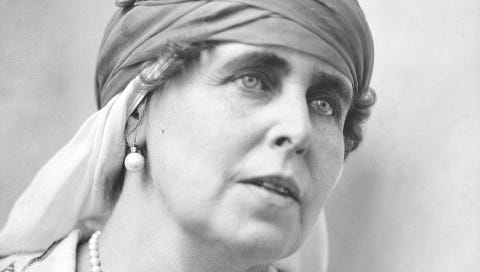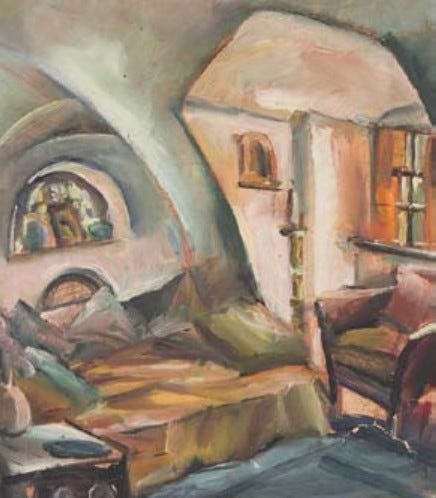This is a fictionalised diary entry from a gossip columnist writing anonymously under the pseudonym “Town Talker”. Direct quotes from news articles of the time are in italics and the references to these articles are given at the end of the piece.
« “It is so home-like and cosy,” Madame Popea told me, almost with tears in her eyes. »
“The Round of the Day”, Westminster Gazette, n°10488, 24th February 1927, p. 4.
25th February 1927
There was a gathering at Claridge’s yesterday afternoon – foreign ministers and their wives from all kinds of countries – Italy, Estonia, Poland, Czechoslovakia, the Kingdom of the Serbs, Croats and Slovenes, etc. ; dear Lucy Baldwin, the wife of our Prime Minister ; the Viscountess Dunedin, a Scottish lady and journalist ; a few Romanian dignitaries ; a gallimaufry of fashionable London socialites.
The occasion was the opening of an exhibition of a pretty Rumanian artist, a certain Elena Popea. Madame Titulesco – wife of the Romanian Minister and a very charming lady – threw a tea party to which she invited me personally. I confess I was impressed: although this was Madame Popea’s first exhibition in our country, she drew quite the crowd.
I had the pleasure of meeting her personally. She told me all kinds of interesting things about her home-country, to which she seems very attached. It is such a strange and foreign land. I remember being very intrigued by the photographs E. O. Hoppé brought back from his travels there. I knew him of course for his portraits of many of the current celebrities – he has made quite the name for himself. He travelled to Rumania in 1923, I believe, and from my understanding sought to grasp the diversity of Rumanian culture, showing the different peoples in traditional dress, and their customs. His portraits were very incisive and gave one a striking image of the spirit of the country. On his return, he published a photographic survey of sorts entitled In Gypsy Camp and Royal Palace: Wanderings in Rumania. I met him at the exhibition he organised at the release of his book – a pleasant man, talented photographer, and shrewd businessman. He conversed at length about his method as a portrait photographer for the rich and famous, and I shall attempt to transcribe as best I can what I remember from our conversation:
“To attempt small talk, especially when photographing some prominent man, is to damn your chances from the outset. You need a fair library of reference books as much as you need plates and films. Before a sitting, you should consult them and thoroughly familiarize yourself with the sitter’s background. If he is a literary man, it may or may not be improving to read one of his books – but at least make yourself acquainted with the titles and keep a weather-eye open for the latest reviews. There is nothing like showing an interest in a man’s work for breaking the ice. (…) The portrait photographer must be a diplomat, putting in a word here and there, not for the purpose of airing his own knowledge, but to evoke a sympathetic response in the sitter which is so essential to successful portraiture.”[1]
I have applied this method in my own line of work, and it has proven very useful. It works wonders when mingling in society, especially when one seeks to maintain the illusion of worldliness and of possessing a certain amount of culture. At the very least, it maintains the illusion just long enough for one to gain the trust and regard of the person one is speaking to, in order to extract all the information one is after. I confess I know very little of Rumania, but familiarising myself with his work proved to be beneficial when talking to the Rumanian dignitaries. I had merely memorised a couple of names of the towns he had travelled to but they were nonetheless pleasantly surprised that I knew a thing or two of their country.
E. O Hoppé, Queen Marie in traditional costume, 1923.
He also mentioned something about Queen Marie of Rumania – an interesting figure in the contemporary political sphere. She was born into the British royal family – she is the granddaughter of Queen Victoria and grew up in England. Now, she is married to King Ferdinand and has completely adopted the customs, dress, and religion of the country. She was of much use in showing E.O. Hoppé around and introducing him to the right people – she is a great patron of the arts in Rumania, and I hear she is an artist herself. He photographed her at her holiday residence in Bran – he was very much impressed by her, as he told me :
“The Queen stood in a blaze of colour, a radiant figure in flowing veil of softest shades, and the castle above seemed to be hanging in the clouds. That was a picture which has impressed itself indelibly on my mind. I christened her palace the Castle of Happiness and she smiled assent. (…) She is a modern fairy queen, with all the high gifts of a very vital and capable woman. She has a perfectly radiant personality, which has a magnetic effect on all within her reach.”[2]
E. O Hoppé, Queen Marie in Bran Castle, 1923.
But I digress. What of Madame Popea’s exhibition? I am nothing of an art critic myself – but I am a rather proficient eavesdropper… From what I heard from those who are more knowledgeable, she “gives us an interesting glimpse of a country in which East and West are mingled” (I could have figured out as much myself), and is a “real colourist”, using colour “either constructively, with the chief purpose of supporting the forms, as in her figure subjects, or decoratively, in still life studies, of which “Tulips,” “Gladioli,” and “Still Life,” green pears, a greener ribbon and a pink flower, are charming examples”. From what I heard, she wears the “garment of Cézanne” with ease – but I shall leave such judgements to those who know best.
For my part, I was particularly drawn to sketches of Rumanian peasants - Madame Titulesco agreed with me that they looked quite Biblical in their long robes and sandals made of strips of plaited cloth; and the interiors of the palace at Bran, being somewhat familiar with the location through the photographs of E. O. Hoppé. Madame Popea goes every year to Bran to see Queen Marie. “It is so home-like and cosy,” she told me, almost with tears in her eyes, as she showed me a sketch of the courtyard, once a dank, barren, stony square, now filled with beds of flowers and flagged paths with a fountain in the centre, and wooden balconies, from which hang still more flowers. What a delightful place it seems! At Bran, everyone, following the example set by the Queen, wears the picturesque native costume.
Elena Popea, Interior of the castle of Bran, oil on cardboard, 49x69,5cm, National Museum of Brukenthal, Sibiu, Romania.
I must confess I found Madame Popea truly enchanting – she is so well travelled and is very engaging. She was busy mingling all afternoon, making sure to talk to everyone. We only exchanged briefly but I had more than enough material for my column in the Westminster Gazette. And now, I must be off ! The Town Talker knows no rest and I have another tea party to attend, hopefully just as entertaining as yesterday’s.
[1] E.O.Hoppé, Hundred Thousand Exposures. The Success of a Photographer, London and New York, 1945, p. 35-36, as cited in Adrian-Silvan Ionescu, “La Grande Roumanie sous l’objectif de E.O. Hoppé”, Revue Roumaine d’histoire de l’art, Série Beaux-Arts, Tome LVI, 2019, p.78.
[2] E.O. Hoppé, In Gipsy Camp and Royal Palace. Wanderings in Rumania, Methuen&Co.Ltd., London, 1924, p. 67, 69, 70, 71, as cited in Adrian-Silvan Ionescu, “La Grande Roumanie sous l’objectif de E.O. Hoppé”, Revue Roumaine d’histoire de l’art, Série Beaux-Arts, Tome LVI, 2019, p.97-98.
Further reading
Adrian-Silvan Ionescu, “La Grande Roumanie sous l’objectif de E.O. Hoppé”, Revue Roumaine d’histoire de l’art, Série Beaux-Arts, Tome LVI, 2019, p. 75–142.
“A Rumanian painter”, The Times, n°44518, 1st March 1927, p. 12.
“Court Circular”, The Times, 26th February 1927, n°44516, p. 13.
“The Round of the Day”, Westminster Gazette, n°10488, 24th February 1927, p. 4.
On Queen Marie at the Bran Castle: « Reședințe regale Castelul Bran », https://reginamaria.org/castelul-bran/.
Previously on The Peripatetic Museum







